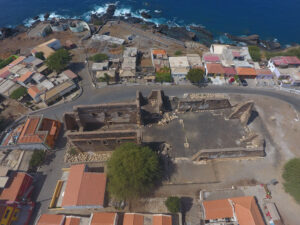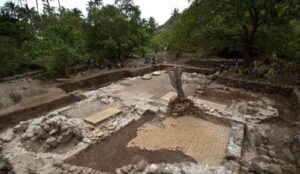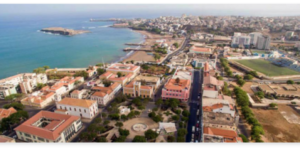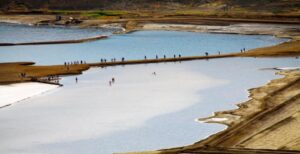
Monuments
A lei cabo-verdiana classifica como monumento as obras arquitetónicas, composições importantes ou criações mais modestas, notáveis pelo interesse histórico, arqueológico, artístico, cientifico, técnico…
Cabo Verde is a State Party of the Convention for the Protection of the World Cultural and Natural Heritage of Paris, 1972. It ratified it in 1987, committing to UNESCO, to protect and enhance the national cultural and natural heritage, allowing its transmission to future generations.
Therefore, article 11 of the Convention provides that each State Party must submit, as far as possible, to the World Heritage Committee (the body responsible for the evaluation of the properties for inscription on the World Heritage List) an inventory of the cultural and natural heritage properties existing in its territory.
LER MAIS
This inventory is called the Indicative List, and it is one of the essential requirements for inscription of a properties on the World Heritage List, apart from the 10 assessment criteria of Outstanding Universal Value (OUV), defined by the World Heritage Committee:
I) Represent a masterpiece of human creative genius;
II) II) Be witness to a considerable exchange of influences, during a given period or in a specific cultural area, on the development of architecture or technology, monumental arts, urban planning or landscape art;
III) III) be a remarkable or at least unique testimony of a cultural tradition or of a civilisation which is living or has disappeared;
IV) IV) Represent an exceptional example of a type of building or architectural or technological ensemble, or landscape that illustrates one or more significant periods of human history;
V) V) Be an exceptional example of traditional human settlement, traditional use of the land or sea, which is representative of a culture (or cultures), or of human interaction with the environment, especially where the latter has become vulnerable under the impact of irreversible changes;
VI) VI) Be directly or materially associated with events or living traditions, ideas, beliefs or artistic and literary works of outstanding universal significance (the Committee considers that this criterion should preferably be used in conjunction with others);
VII) VII) Represent remarkable natural phenomena or areas of outstanding natural beauty and aesthetic importance;
VIII) VIII) Be exceptionally representative examples of the great stages of the Earth's history, namely testimonies of life, of geological processes underway in the development of landforms or of geomorphic or physiographic elements of great significance;
XIX) XIX) Be exceptionally representative examples of ecological and biological processes taking place in the evolution and development of terrestrial, aquatic, coastal and marine ecosystems and plant and animal communities;
X) X) Contain the most representative natural habitats that are of greatest importance for in-situ conservation of biological diversity, including those hosting threatened species of outstanding universal value from the point of view of science or conservation.
Cabo Verde made its first Indicative List in 2003, which included the following properties: Parque Natural de Cova, Paúl e Ribeira da Torre (Santo Antão); Salinas de Pedra de Lume (Sal); Centro histórico da Praia (Santiago); Campo de Concentração do Tarrafal (Santiago); Centro histórico de São Filipe e Chã das Caldeiras (Fogo).
One of the requirements of the World Heritage Committee is that every ten years, or whenever possible, the States Parties to the Convention of 1972 update their Indicative List. In view of this requirement, Cabo Verde updated its list in 2016 by adding two more properties, namely : Reserva Natural de Santa Luzia and Reservas Integrais dos Ilhéus Raso e Branco; and the Centro Histórico of Nova Sintra, na Ilha Brava.
LER MENOS

A lei cabo-verdiana classifica como monumento as obras arquitetónicas, composições importantes ou criações mais modestas, notáveis pelo interesse histórico, arqueológico, artístico, cientifico, técnico…

A legislação cabo-verdiana, lei nº 102/III/90, revogado pela Lei nº 85/IX/2020, de 20 de abril, enquadra os bens arqueológicos imóveis ou móveis, terrestres…

Em 1976 saiu da conferência da UNESCO em Nairobi a definição do conjunto histórico urbano, que tenta conjugar a preservação da urbe com…

São classificados como sítios históricos, as obras do homem ou obras conjuntas do homem e da natureza, espaços suficientemente característicos e homogéneos, notáveis …
Cabo Verde is a State member of Convention for the Protection of the World Cultural and Natural Heritage of Paris, 1972. It was amended in 1987, committing to UNESCO to protect and enhance the national cultural and natural heritage, allowing its transmission to future generations.
Article 11 of the Convention therefore stipulates that each State member shall submit, as far as possible, to the World Heritage Committee (the body responsible for evaluating properties for inscription on the World Heritage List) an inventory of the cultural and natural heritage properties located on its territory.
ler mais
I) Represent a masterpiece of human creative genius;
II) II) Be witness to a considerable exchange of influences, during a given period or in a specific cultural area, on the development of architecture or technology, monumental arts, urban planning or landscape art;
III) III) be a remarkable or at least unique testimony of a cultural tradition or of a civilisation which is living or has disappeared;
IV) IV) Represent an exceptional example of a type of building or architectural or technological ensemble, or landscape that illustrates one or more significant periods of human history;
V) V) Be an exceptional example of traditional human settlement, traditional use of the land or sea, which is representative of a culture (or cultures), or of human interaction with the environment, especially where the latter has become vulnerable under the impact of irreversible changes;
VI) VI) Be directly or materially associated with events or living traditions, ideas, beliefs or artistic and literary works of outstanding universal significance (the Committee considers that this criterion should preferably be used in conjunction with others);
VII) VII) Represent remarkable natural phenomena or areas of outstanding natural beauty and aesthetic importance;
VIII) VIII) Be exceptionally representative examples of the great stages of the Earth's history, namely testimonies of life, of geological processes underway in the development of landforms or of geomorphic or physiographic elements of great significance;
XIX) XIX) Be exceptionally representative examples of ecological and biological processes taking place in the evolution and development of terrestrial, aquatic, coastal and marine ecosystems and plant and animal communities;
X) X) Contain the most representative natural habitats that are of greatest importance for in-situ conservation of biological diversity, including those hosting threatened species of outstanding universal value from the point of view of science or conservation.
Cabo Verde fez a sua primeira Lista Indicativa em 2003 e contava com os seguintes bens: Parque Natural de Cova, Paul e Ribeira da Torre (Santo Antão); Salinas de Pedra de Lume (Sal); Centro histórico da Praia (Santiago); Campo de Concentração do Tarrafal (Santiago); Centro histórico de São Filipe e Chã das Caldeiras (Fogo).
Uma das exigências do Comité do Património Mundial, é que a cada dez anos ou sempre que possível, os Estados Parte da Convenção de 1972, atualizem a sua Lista Indicativa. Tendo em conta este quesito, Cabo Verde fez a atualização da sua lista em 2016, atualizando as informações da lista de 2003 e acrescentando mais dois bens, a saber: Reserva Natural de Santa Luzia e Reservas Integrais dos Ilhéus Raso e Branco; e o Centro Histórico de Nova Sintra na ilha Brava.
ler menos
A Direção de Monumentos e Sítios (DMS) é o serviço do IPC encarregado de coordenar, fiscalizar, e executar ações respeitantes à salvaguarda, proteção, desenvolvimento e promoção do património cultural imóvel.
A Direção de Monumentos e Sítios é composta por uma equipa multidisciplinar, de arquitetos, arqueólogos, historiadores, geógrafos e gestores de património.
ler mais
ler menos